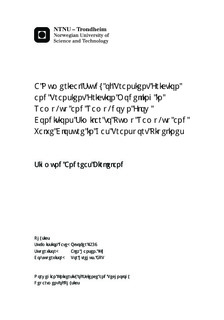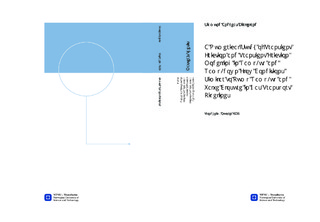| dc.description.abstract | When gas is transported in long pipelines, computational models are used as tools to plan and to optimize hydraulic capacities. Because of the length of the pipelines the models are mostly one-dimensional (1D) which in turn requires input parameters like a friction factor and heat transfer coefficients. These parameters are usually the result of steady state correlations. There are doubts about the validity of using steady state correlation in transient periods.
The objective of this thesis was to simulate transient periods with an one-dimensional (1D) model and a more detailed two-dimensional (2D) model from a commercial CFD package, extracting the friction factor and then comparing the resulting friction factors from the two models.
The RANS $k$-$\omega$ model was chosen from a set of criteria. To limit the computational demand, periodic boundary conditions were used at the inlet and the outlet of the pipe-segment and the flow was simplified to be isothermal, incompressible, and with constant viscosity. Furthermore, an 1D model was derived and three different friction models were implemented, namely the quasi-steady friction model, the Instantaneous Acceleration Based (IAB) Daily et al. model, and the Vardy et al. friction model. Transient periods, defined as ramp-up and ramp-down flows, were simulated by the models. Ramp-up and ramp-down transients are seen as a sudden increase or decrease in pressure difference, resembling a valve opening or closing. The pressure difference, bulk velocity, and wall shear stress was extracted from the 1D and 2D simulations. In addition, velocity profiles and turbulence profiles were extracted from the 2D simulations.% The steady component of the wall shear stress was subtracted from the 2D wall shear stress to find the unsteady behaviour of the wall shear stress.
There were significantly larger differences between quasi-steady friction factor and transient friction factor in ramp-up flows than in ramp-down flow. In ramp-up simulations the transient friction went from overshooting the steady friction factor by $152$\% to undershooting it by $55$\%; all within the first $1/10$ of the transient. In the corresponding ramp-down simulation the maximum difference was only $1.45$\%. However, the error between the 1D velocity and the 2D bulk velocity in the ramp-up cases was below the 2D model's velocity uncertainty. Moreover, the opposite was seen in the ramp-down cases, where the error between the 1D and 2D velocity was upwards of $20\%$
In the ramp-up cases four turning points of the transient component of the wall shear stress were identified, and of those, two were directly coupled to the turbulence diffusion time and the turbulence production delay.
From the results it was found that the use of quasi-steady friction modelling in transient models gave a fairly good approximation of the wall shear stress in decelerating transients; however, the predicted velocity significantly undershot the 2D velocity. In the ramp up simulations the 1D models did not capture the highly varying 2D wall shear stress at the initial stage of the transients, but the 1D models predicted the velocity with reasonable accuracy. Neither of the implemented 1D transient friction models yielded satisfactory wall shear stress prediction. Overall, the results suggest that better friction models are needed, and that such models can significantly improve the accuracy of transient gas transport models. | |

